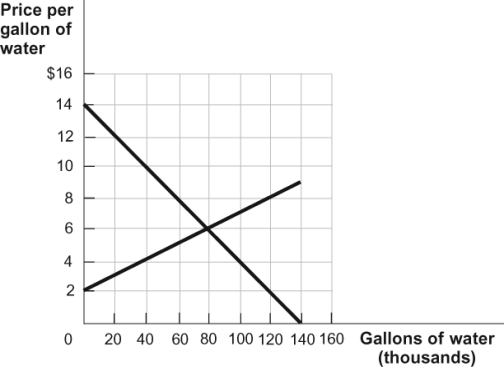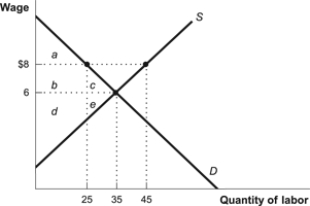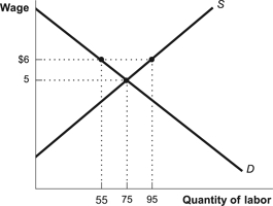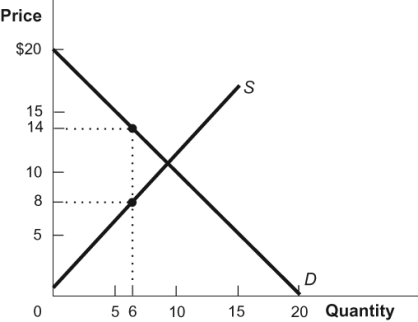Correct Answer

verified
Correct Answer
verified
True/False
Suppose a $3 per gallon price ceiling is imposed on gasoline, and the equilibrium price of gasoline is $2 per gallon. Such a price ceiling would lead to long lines at gas stations.
Correct Answer

verified
Correct Answer
verified
Multiple Choice
Airline regulation from 1938 to 1978 was successful in keeping prices high because:
A) it controlled price, but not entry into the airline market.
B) it controlled both price and entry into the airline market.
C) it listened to the requests of suppliers during this time at the expense of consumers.
D) of declining production costs.
Correct Answer

verified
Correct Answer
verified
Multiple Choice
Price floors would create all of the following effects EXCEPT:
A) surpluses.
B) deadweight loss.
C) wasteful decreases in product quality.
D) misallocation of resources.
Correct Answer

verified
Correct Answer
verified
Multiple Choice
Use the following to answer questions: Figure: Water Market  -(Figure: Water Market) Refer to the figure. If a price floor in the diagram gets set at $8 a gallon, how big is the shortage or surplus?
-(Figure: Water Market) Refer to the figure. If a price floor in the diagram gets set at $8 a gallon, how big is the shortage or surplus?
A) 60,000 gallons in surplus
B) 120,000 gallons in surplus
C) 60,000 gallons in shortage
D) 12,000 gallons in shortage
Correct Answer

verified
Correct Answer
verified
Multiple Choice
Which of these statements explains why price ceilings result in lost gains from trade?
A) Buyers and sellers want to trade, but the threat of fines or jail time prevents them from doing so.
B) Sellers want to trade, but buyers prefer the lower prices.
C) Buyers want to trade, but sellers are indifferent at the lower prices.
D) Neither buyers nor sellers want to trade subject to a price ceiling resulting in lost gains from trade.
Correct Answer

verified
Correct Answer
verified
Multiple Choice
A rent control is a price:
A) floor on car rentals.
B) ceiling on car rentals.
C) floor on rental housing.
D) ceiling on rental housing.
Correct Answer

verified
Correct Answer
verified
Multiple Choice
A price floor:
A) is a maximum price allowed by law.
B) is a minimum price allowed by law.
C) has an effect only when it is set below the market price.
D) has little effect on market activity.
Correct Answer

verified
Correct Answer
verified
Multiple Choice
Use the following to answer questions: Figure: Minimum Wage  -Figure: Unskilled Labor Market
-Figure: Unskilled Labor Market  Based on the figure, what is the number of unemployed workers if a minimum wage of $6 is set in this market for unskilled labor?
Based on the figure, what is the number of unemployed workers if a minimum wage of $6 is set in this market for unskilled labor?
A) 40
B) 55
C) 20
D) 95
Correct Answer

verified
Correct Answer
verified
Multiple Choice
In Ancient Egypt, the "Bronze Law" set maximum prices for wages, preventing them from rising above what rulers perceived as the minimum needed to survive. If this was 10¢ a day for a porter (someone who carries things short distances) and the market wage was 8¢ a day, which of the following would be a plausible consequence of this law?
A) Porters would travel less quickly than they otherwise would.
B) Porters would transport items they normally would not.
C) Unemployment for porters would decrease.
D) Nothing unusual would happen.
Correct Answer

verified
Correct Answer
verified
True/False
If price ceilings do not allow prices to rise, then demanders will be unable to signal their needs to suppliers.
Correct Answer

verified
Correct Answer
verified
Multiple Choice
Which statement(s) is TRUE? Price floors set above the equilibrium price cause: I. shortages. II. surpluses. III. deadweight losses.
A) I and III only
B) II and III only
C) III only
D) I is true if demand is elastic; however, II is true if demand is inelastic.
Correct Answer

verified
Correct Answer
verified
Multiple Choice
Which statement is TRUE in a market with a price ceiling?
A) Buyers and sellers experience unexploited gains from trade.
B) Resources are allocated to their most efficient uses.
C) The supply of goods is sold by the sellers with the lowest costs.
D) The supply of goods is bought by the buyers with the highest willingness to pay.
Correct Answer

verified
Correct Answer
verified
Multiple Choice
The quantity exchanged of a good ______ under a binding price floor.
A) rises
B) remains the same
C) falls
D) changes in an indeterminate direction
Correct Answer

verified
Correct Answer
verified
Multiple Choice
Which statement is FALSE?
A) A frost that destroys half the orange crop will create a surplus of oranges.
B) It is possible to have a shortage of a good even if its supplies are abundant.
C) Politicians often blame speculators and profiteers for rising prices rather than changes in supply and demand.
D) To eliminate a shortage, prices must rise.
Correct Answer

verified
Correct Answer
verified
Multiple Choice
Deadweight loss is:
A) necessary to ensure that resources are channeled to their highest-valued use.
B) the loss to the economy from firms going out of business due to competition.
C) usually offset by deadweight gains.
D) the total of lost consumer and producer surplus when not all mutually profitable gains from trade are exploited.
Correct Answer

verified
Correct Answer
verified
Multiple Choice
Which would NOT happen as the result of a price floor?
A) a surplus of the good
B) lost gains from trade
C) misallocation of resources
D) decreases in product quality
Correct Answer

verified
Correct Answer
verified
Multiple Choice
In 1972-1973, the swimming pools in California were heated but homes in New Jersey were cold, is an example of a(n) :
A) misallocation of resources caused by price controls.
B) market failure caused by speculators.
C) market inefficiency caused by monopoly oil companies.
D) excess supply of oil caused by the business cycle.
Correct Answer

verified
Correct Answer
verified
Multiple Choice
Use the following to answer question 96:
Figure: Supply and Demand 3  -(Figure: Supply and Demand 3) Refer to the figure. If the government sets a price ceiling at $8 in this figure, it will create a deadweight loss of:
-(Figure: Supply and Demand 3) Refer to the figure. If the government sets a price ceiling at $8 in this figure, it will create a deadweight loss of:
A) $6.
B) $36.
C) $9.
D) $24.
Correct Answer

verified
Correct Answer
verified
True/False
During the 1970s, the 11-tier oil production definitions came into play because of firms' attempts to bypass regulations and produce decontrolled oil.
Correct Answer

verified
Correct Answer
verified
Showing 61 - 80 of 325
Related Exams